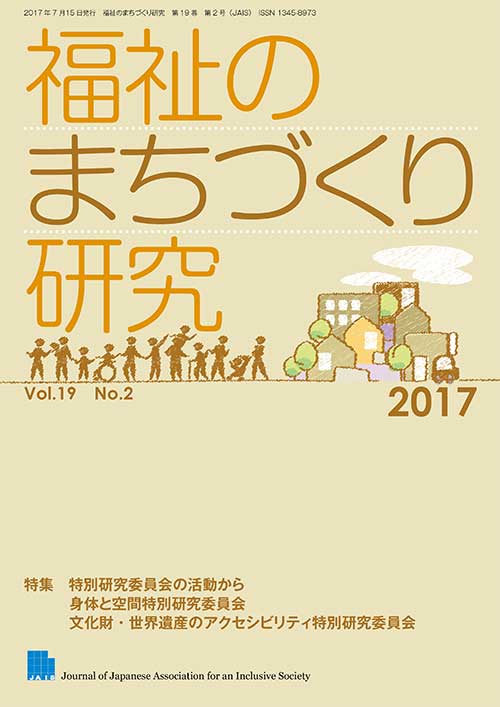Volume 19, Issue 2
Displaying 1-26 of 26 articles from this issue
- |<
- <
- 1
- >
- >|
-
2017Volume 19Issue 2 Pages Cover1-
Published: July 15, 2017
Released on J-STAGE: March 22, 2018
Download PDF (293K)
-
2017Volume 19Issue 2 Pages A-
Published: July 15, 2017
Released on J-STAGE: March 22, 2018
Download PDF (1026K)
-
2017Volume 19Issue 2 Pages 1-12
Published: July 15, 2017
Released on J-STAGE: March 22, 2018
Download PDF (1404K) -
2017Volume 19Issue 2 Pages 13-22
Published: July 15, 2017
Released on J-STAGE: March 22, 2018
Download PDF (1281K) -
2017Volume 19Issue 2 Pages 23-34
Published: July 15, 2017
Released on J-STAGE: March 22, 2018
Download PDF (1520K)
-
2017Volume 19Issue 2 Pages 35-
Published: July 15, 2017
Released on J-STAGE: March 22, 2018
Download PDF (946K)
-
2017Volume 19Issue 2 Pages B-C
Published: July 15, 2017
Released on J-STAGE: March 22, 2018
Download PDF (1010K)
-
2017Volume 19Issue 2 Pages 37-38
Published: July 15, 2017
Released on J-STAGE: March 22, 2018
Download PDF (1075K)
-
2017Volume 19Issue 2 Pages 39-
Published: July 15, 2017
Released on J-STAGE: March 22, 2018
Download PDF (985K)
-
2017Volume 19Issue 2 Pages 40-51
Published: July 15, 2017
Released on J-STAGE: March 22, 2018
Download PDF (1342K) -
2017Volume 19Issue 2 Pages 52-55
Published: July 15, 2017
Released on J-STAGE: March 22, 2018
Download PDF (1375K)
-
2017Volume 19Issue 2 Pages 56-59
Published: July 15, 2017
Released on J-STAGE: March 22, 2018
Download PDF (2141K) -
2017Volume 19Issue 2 Pages 60-64
Published: July 15, 2017
Released on J-STAGE: March 22, 2018
Download PDF (1153K)
-
2017Volume 19Issue 2 Pages 65-79
Published: July 15, 2017
Released on J-STAGE: March 22, 2018
Download PDF (1261K)
-
2017Volume 19Issue 2 Pages 80-83
Published: July 15, 2017
Released on J-STAGE: March 22, 2018
Download PDF (1206K)
-
2017Volume 19Issue 2 Pages 84-
Published: July 15, 2017
Released on J-STAGE: March 22, 2018
Download PDF (1004K)
-
2017Volume 19Issue 2 Pages 85-86
Published: July 15, 2017
Released on J-STAGE: March 22, 2018
Download PDF (968K)
-
2017Volume 19Issue 2 Pages 87-
Published: July 15, 2017
Released on J-STAGE: March 22, 2018
Download PDF (1058K)
-
2017Volume 19Issue 2 Pages 88-
Published: July 15, 2017
Released on J-STAGE: March 22, 2018
Download PDF (987K)
-
2017Volume 19Issue 2 Pages 89-90
Published: July 15, 2017
Released on J-STAGE: March 22, 2018
Download PDF (1188K)
-
2017Volume 19Issue 2 Pages 91-103
Published: July 15, 2017
Released on J-STAGE: March 22, 2018
Download PDF (1960K)
-
2017Volume 19Issue 2 Pages 104-
Published: July 15, 2017
Released on J-STAGE: March 22, 2018
Download PDF (1490K)
-
2017Volume 19Issue 2 Pages 105-
Published: July 15, 2017
Released on J-STAGE: March 22, 2018
Download PDF (1128K)
-
2017Volume 19Issue 2 Pages 106-
Published: July 15, 2017
Released on J-STAGE: March 22, 2018
Download PDF (948K)
-
2017Volume 19Issue 2 Pages 107-
Published: July 15, 2017
Released on J-STAGE: March 22, 2018
Download PDF (53K)
-
2017Volume 19Issue 2 Pages Cover2-
Published: July 15, 2017
Released on J-STAGE: March 22, 2018
Download PDF (293K)
- |<
- <
- 1
- >
- >|
